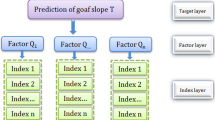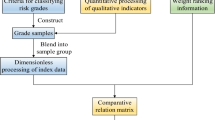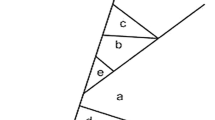Abstract
Considering the uncertainty and complexity of the influencing factors, the present study focused on the multi-level and multi-index evaluation system for analyzing rock slope stability. Quantitative analysis of the influence degree of the evaluation index on the rock slope stability was carried out by extension theory. The most significant factors affecting rock slope stability and the corresponding evaluation index were obtained. Further, the study presents a concept about the instability characterization coefficient of the key block, which is an important factor controlling slope stability. With this coefficient implemented into the search module of key blocks in the program Geotechnical Structure and Model Analysis-3D (GeoSMA-3D), developed by the corresponding author’s team, a further determination and visualization of key blocks were achieved. However, in many previous studies, there was no good correlation between the theoretical key blocks and the actual rock slope engineering, which led to derailment between theoretical analysis and practical engineering. Hence, this paper proposed the characterization safety factor of rock slope stability that combined the instability characterization coefficient with the weight of key blocks. The influence degree of each key block on rock slope stability was determined by the size of the instability characterization coefficient of key blocks. The weight of each key block on the slope stability was determined by combining this coefficient with the analytic hierarchy process (AHP). The key block information was applied to characterize the rock slope stability. The present study proposed a convenient and feasible evaluation method regarding rock slope stability. For the specific rock slope engineering, the significance of each evaluation index was determined and the most significant index was obtained. The determination and visualization of key blocks and the judgment of the slope stability were investigated, which verified the applicability and feasibility of this evaluation method.













Similar content being viewed by others
References
Binod T, Beena A (2015) Reduction in fully softened shear strength of natural clays with NaCl leaching and its effect on slope stability. J Geotech Geoenviron 141(1):1197–1209
Cai W (1990) The extension set and non-compatible problem. Adv Math Mech China 2:1–21
Cai W (1994) Matter-element models and their application. Science and Technology, Beijing
Cai W (1999) Extension theory and its application. Chin Sci Bull 17:1538–1548
Cao LJ, Liu YN, Shang guan ZC (2013) Stability analysis of jointed rock slope using shear strength reduction approach. Appl Mech Mater 2746(423):1321–1324
Chen N, Kemeny J, Jiang QH, Pan ZW (2017) Automatic extraction of blocks from 3D point clouds of fractured rock. Comput Geosci 109:149–161
Chi EA, Tao TJ, Zhao MS, Kang Q (2014) Failure mode analysis of bedding rock slope affected by rock mass structural plane. Appl Mech Mater 3365(602):594–597
Deng HF, Zhou ML, Li JL, Sun XS, Huang YL (2016) Creep degradation mechanism by water-rock interaction in the red-layer soft rock. Arab J Geosci 9:42–57
Goodman RE, Shi GH (1985) Block theory and its application to rock engineering. Prentice-Hall, Englewood
Griffiths DV, Marquez RM (2007) Three-dimensional slope stability analysis by elasto-plastic finite elements. Geotechnique 57(6):537–546
Guo MD, Zhu FS, Wang SH, Zhang SC, Zhang J (2013) Research on rock bridge coalescence law of rock mass containing coplanar structural planes. Rock Soil Mech 06:1598–1604
Guo ZQ, Chen WW, Zhang JK, Ye F, Liang XZ, He FG, Guo QG (2017) Hazard assessment of potentially dangerous bodies within a cliff based on the fuzzy-AHP method: a case study of the Mogao grottoes, China. Bull Eng Geol Environ 76:1009–1020
Hao J, Shi KB, Chen GM, Bai XJ (2014) Block theory of limited trace lengths and its application to probability analysis of block sliding of surrounding rock. Chin J Rock Mech Eng 07:1471–1478
Hisham TE, Khaled HR, Dharma W (2016) Drained residual shear strength at effective normal stresses relevant to soil slope stability analyses. Eng Geol 204(8):94–107
Huang JW, Li JL, Zhou YH (2007) Application of fuzzy analysis based on AHP to slope stability evaluation. Chin J Rock Mech Eng 26(1):2627–2632
Jiang QH, Zhou CB (2017) A rigorous solution for the stability of polyhedral rock blocks. Comput Geotech 90:190–201
Jiang QH, Liu XH, Wei W, Zhou CB (2013) A new method for analyzing the stability of rock wedges. Int J Rock Mech Min Sci 60(6):413–422
Kumsar H, Aydan O, Ulusay R (2000) Dynamic and static stability assessment of rock slopes against wedge failures. Rock Mech Rock Eng 33(1):31–51
Li KG, Hou KP, Li W (2009) Research on influences of factors dynamic weight on slope stability. Rock Soil Mech 30(2):492–496
Li CD, Wu JJ, Wang J, Li XK (2016) Layout and length optimization of anchor cables for reinforcing rock wedges. Bull Eng Geol Environ 75(4):1399–1412
Liu CH (2016) On improving the classification accuracy of extension theory. Intell Decis Technol 10(1):27–36
Liu GS, Qi CM, Nie CL, Hu J (2013) Slope stability evaluation by the improved AHP and extension theory. Appl Mech Mater 2685(405):106–110
Qi SW, Xu Q, Lan HX, Zhang B, Liu JY (2010) Spatial distribution analysis of landslides triggered by 2008.5.12 Wenchuan earthquake, China. Eng Geol 116(1):95–108
The Ministry of Water Resources, PRC (2015) Standard for engineering classification of rock mass, GB50218-2014. China Planning Press, Beijing
Wang SH, Ni PP (2014) Application of block theory modeling on spatial block topological identification to rock slope stability analysis. Int J Computat Methods 11(1):1–24
Wang SH, Guo MD, Yang Y (2009) Enhancing block rock failure understanding through GeoSMA-3D numerical analysis. ISRM international symposium on rock mechanics: rock characterization, modelling and engineering design method, SINOROCK 2009, Hong Kong, pp 158–164
Wang SH, Ni PP, Yang H, Xu Y (2011) Modeling on spatial block topological identification and their progressive failure analysis of slope and cavern rock mass. Procedia Eng 10:1509–1514
Wang SH, Huang RQ, Ni PP (2013a) Fracture behavior of intact rock using acoustic emission: experimental observation and realistic modeling. Geotech Test J 36(6):903–914
Wang SH, Ni PP, Guo MD (2013b) Spatial characterization of joint planes and stability analysis of tunnel blocks. Tunn Undergr Space Technol 38(1):357–367
Wang SH, Wang FL, Zhang ZS (2017) Blocks searching and program development based on overlapping technology. J Northeast Univ (Nat Sci) 38(02):265–269
Wen HJ, Xie P, Xiao P, Hu DP (2017) Rapid susceptibility mapping of earthquake-triggered slope geohazards in Lushan County by combining remote sensing with the AHP model developed for the Wenchuan earthquake. Bull Eng Geol Environ 76:909–921
Wu W, Zhu HH, Lin JS, Zhuang XY, Ma GW (2018) Tunnel stability assessment by 3D DDA-key block analysis. Tunn Undergr Space Technol 71(1):210–214
Xia CY, Liu YJ, Liu DM (2011) Method of weight assignment for multi-criterion based on Grey interval AHP. Adv Mater Res 1269(243):5285–5288
Xie Y, Liu J, Li ZK, Zhang ZY (2006) Stability analysis of block in surrounding rock mass of large underground excavation. Chin J Rock Mech Eng 02:306–311
Yang Y, Wang SH et al (2009) Visual program based on general block theory. New development in rock mechanics and engineering & Sanya forum for the plan of city and city construction, Sanya, pp 351–358
Yu QC, Chen DJ, Xue GF, Daxi YS (2005) Preliminary study on the general block theory of fractured rock mass. Hydrogeoloogy Eng Geol 06:42–48
Zhang QH, Wu AQ (2005) Morphological analysis method of block based on classification of concave zone. Chin J Geotech Eng 03:299–303
Zhang QH, Wu AQ (2007) General methodology of spatial block topological identification with stochastic discontinuities cutting. Chin J Rock Mech Eng 10:2043–2048
Zhang MS, Huang RQ, Wang SH (2016a) Spatial block identification method based on meshing and its engineering application. Chinese Journal of Geotechnical Engineering 38(3):477–485
Zhang X, Jiang Q, Chen N, Wei W, Feng X (2016b) Laboratory investigation on shear behavior of rock joints and a new peak shear strength criterion. Rock Mech Rock Eng 49:3495–3512
Zhao B, Xu WY, Liang GL, Meng YD (2015) Stability evaluation model for high rock slope based on element extension theory. Bull Eng Geol Environ 74(2):301–314
Zheng YR, Ye HL, Huang RQ (2009) Analysis and discussion of failure mechanism and fracture surface of slope under earthquake. Chin J Rock Mech Eng 28(8):1714–1723
Zheng YH, Xia L, Yu QC (2013) Stability analysis method of block considering cracking of rock bridge. Rock Soil Mech S1:197–203
Zhong W, Tan ZY, Qiao L (2011) Stability analysis of rock slope based on preferred structural plane. Adv Mater Res 1269(243):243–249
Zhou ZJ, Liang H, Wang XD (2012) Study on stability of rock at reservoir banks slop based on AHP. Appl Mech Mater 1975(204):2309–2317
Acknowledgements
This work was conducted with supports from the National Natural Science Foundation of China (Grant Nos. 51474050 and U1602232), the Program for Liaoning Excellent Talents in University (Grant No. LN2014006) to Dr. Shuhong Wang.
Author information
Authors and Affiliations
Corresponding author
Rights and permissions
About this article
Cite this article
Wang, F., Wang, S., Hashmi, M.Z. et al. The characterization of rock slope stability using key blocks within the framework of GeoSMA-3D. Bull Eng Geol Environ 77, 1405–1420 (2018). https://doi.org/10.1007/s10064-018-1291-9
Received:
Accepted:
Published:
Issue Date:
DOI: https://doi.org/10.1007/s10064-018-1291-9




